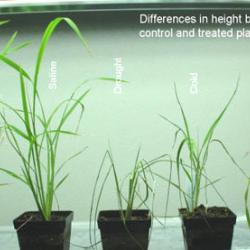Source Institutions
Source Institutions
Add to list Go to activity
Activity link broken? See if it's at the internet archive

The purpose of this plant biotechnology activity is to demonstrate the effect of changes in the environment on the growth and fertility of landscape grasses and crop grasses such as wheat and rice. Plants are placed in environments such as high salinity, cold, heat, or drought and learners observe the different reactions of the plants to these conditions. Learners compare the growth of treated plants to that of the control plants, which are grown under optimal conditions. Learners then discuss the desirability of breeding new types of plants that are better able to withstand these changes if they occur in the general environment. In the original description of the activity, the planting is prepared by the instructor as a demonstration, but learners could be involved in this process. This resource contains background information and questions for learners.
- 1 to 12 months
- 45 to 60 minutes
- $10 - $20 per group of students
- Ages 11 - 18
- Activity, Demonstration, Experiment/Lab Activity, Lesson/Lesson Plan
- English
Quick Guide
Materials List (per group of students)
- 25 germinated seeds of wheat or rice
- 16 10-cm (4") pots
- Potting soil/peat moss mixed 1:1
- 5 small containers to hold pots
- Aquarium or other clear container with lid or top
- Table salt (NaCl)
- Scale to weigh NaCl
- 1-liter measuring cylinder, volumetric flask or kitchen measuring jug
- Full spectrum grow-lights if necessary
- Use of refrigerator or cold room
- Filter paper
- set at 28°C or in an area that is warmed by the sun
- 10% bleach
- Distilled water
- Fertilizer (follow the directions for potted plants for whichever fertilizer you choose)
- Activity sheets
- Rulers or measuring tapes
Subjects
-
Engineering and Technology
-
Engineering
- Agricultural Engineering
- Bioengineering/Biomedical Engineering
-
Technology
- Agriculture and Biotechnology
-
Engineering
-
Life Sciences
- Cells
-
Diversity of Life
- Plants
-
Heredity and Genetics
- Patterns of Heredity
- Genetic Engineering
-
Physical Sciences
- Chemistry
-
Mathematics
-
Data Analysis and Probability
- Data Analysis
- Data Collection
- Measurement
-
Data Analysis and Probability
-
The Nature of Science
-
Science and Society
- Risks and Benefits
- Ethics
-
The Scientific Process
- Conducting Investigations
- Gathering Data
- Formulating Explanations
- Communicating Results
-
Science and Society
Informal Categories
- Gardening
- Nature and Environment
Audience
To use this activity, learners need to:
- see
- see color
- read
- touch
Learning styles supported:
- Involves hands-on or lab activities
Other
Components that are part of this resource:
This resource is part of:
Access Rights:
- Free access
By:
- Stephens, Janice ; Leach, Jan
Rights:
- All rights reserved, The American Phytopathological Society, 2011
